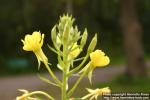
 The root, bark, leaves, and twigs of Oenothera biennis, Linné.
The root, bark, leaves, and twigs of Oenothera biennis, Linné.
Nat. Ord.—Onagraceae.
COMMON NAMES: Evening primrose, Tree primrose.
Botanical Source.—This is an indigenous, biennial plant, with an erect, rough, hirsute, and branching stem, from 2 to 5 feet high. The leaves are ovate lanceolate, alternate, acute, obscurely toothed, roughly pubescent, 3 to 6 inches long, ½ to 1 ½ inches broad, those on the stem sessile, the radicles tapering into a petiole. The flowers are numerous, pale-yellow, sessile, odorous, in a terminal, somewhat leafy spike; they are nocturnal, open but once by night, and continue only a single day. The calyx tube is 2 or 3 times longer than the ovary, deciduous, 4-lobed, and reflexed. Petals 4, equal, obcordate, or obovate, inserted into the top of the tube. Stamens 8, a little shorter than the petals. Anthers mostly linear. Capsule oblong, somewhat tapering above, 3-celled, and 4-valved. Seeds numerous, naked, and in 2 rows in each cell (G.—W.).
History.—Tree primrose grows throughout the country in fields and waste places, flowering in July and August. There are several varieties of it, as Oe. muricata, Oe. grandiflora, Oe. parviflora, Oe. cruciata, and Oe. canescens. When growing in retired, isolated places, a white substance appears on the leaves, rendering them apparently very downy. By cultivating the plant, its flowers improve, growing much larger, and acquiring a darker hue. Each flower opens at the dusk of evening, and does not close till about 9 or 10 o'clock the next morning, after which they do not open again. Pursh remarks that he has "frequently observed a singularity in this plant, and it might be interesting to make further inquiry into its cause; it is that in a dark night, when no objects can be distinguished at an inconsiderable distance, this plant, when in full flower, can be seen at a great distance, having a bright white appearance, which probably may arise from some phosphoric properties of the flowers." The bark, leaves, and twigs are the parts used. Their taste is very viscid, with a subsequent slight acrimony, which last is diminished by desiccation. Water takes up the properties of the plant.
Chemical Composition.—The stem of this plant contains tannin (Braconnot). Mucilage is abundant. The oenotherin of Chicoisneau (1834) is composed of several substances, and has not been well studied. The alcoholic extract of Oe. biennis sometimes deposits crystals of potassium nitrate (Amer. Jour. Pharm., 1884, p. 365).
Action, Medical Uses, and Dosage.— Ɣ An ointment made by boiling the twigs, leaves, and bark, in lard or tallow—or a strong decoction of these—has been found very efficient in curing tetter, milk-scall, and other cutaneous affections of infants. Collect the material when the plant is in flower. In fomentation, or when recent, the bruised leaves form an excellent application to ulcers. Internally, oenothera has been used for a number of purposes, and its specific field of action seems none too well established. It has, however, been accorded a place in the treatment of gastro-intestinal disorders of a functional character. Dr. Scudder points out as the indications for it, a sallow, dirty skin, with full and expressionless tissues, an expressionless face, an unnatural and large tongue, having the sallow, dirty hue of the skin, and the patient's mentality is of a gloomy and despondent character. Under these conditions he has employed it with success in dyspepsia, hepatic torpor, splenic and mesenteric glandular enlargements, and in female disorders, with torpor and pelvic fullness. The dyspepsia met by it is that form associated with vomiting, distressing sensations after taking food, restlessness at night, and frequent desire to pass urine. When cholera infantum and watery diarrhoeas assume a choleraic form, it has been asserted to act well, as it does in dysentery, with marked tenesmus and bloody stools. The intestinal irritation and consequent liability to destructive inflammation of Peyer's patches, in enteric fever, is said to be lessened by the timely administration of oenothera (Webster). It relieves difficult respiration and chronic asthma, with gastric complication. The dose of the fluid extract ranges from 5 to 30 drops; of a strong tincture of the recent plant (98 per cent alcohol), from 1 to 15 drops.
Specific Indications and Uses.—Sallow, dirty skin, tissues full and expressionless, tongue unnatural in size and color, being large and of the dirty color of the skin, face dull and apathetic; dyspepsia, with vomiting of food, and gastric distress, with desire to urinate frequently; choleraic and dysenteric discharges; nocturnal restlessness; innervation feeble; patient gloomy and despondent; atonic reproductive wrongs of the female, with pelvic fullness.

